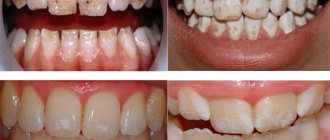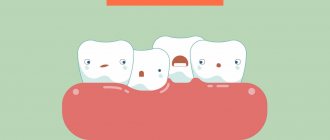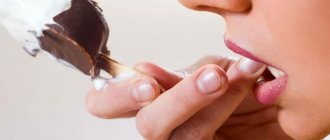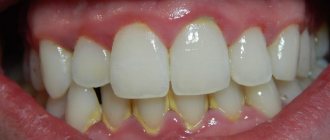- What are the benefits of fluoride?
- Why is fluoride deficiency dangerous?
- If there is too much fluoride in the body
- Fluoride products for teeth
- Water fluoridation
- Fluoride in toothpastes
- Can children have toothpaste with fluoride?
- Is there an alternative?
Most dental and oral care products contain fluoride. This is an important substance that helps strengthen enamel and prevents the spread of pathogenic microflora.
In the body, fluoride is contained in tooth enamel and bones in an amount of about 2.5–3 g. Our daily need for it is 1.5–5 mg. With a lack of this element, caries forms on the teeth. Therefore, in the USA and some European countries, fluoride is recommended for addition to drinking water and toothpastes.
Recently, articles have increasingly appeared that fluoride in toothpaste is harmful. Is it true? Let's try to figure it out.
What are the benefits of fluoride?
Fluoride performs important tasks in the body.
- Together with phosphorus and calcium, it participates in the formation and strengthening of bone tissue and tooth enamel
. - Promotes healthy nail and hair
. - Stimulates hematopoietic
: formation, development and maturation of red blood cells, platelets and leukocytes. - Strengthens the immune system
and maintains it at an appropriate level. - Removes salts of radionuclides and heavy metals
.
When used in oral care products, fluoride helps prevent dental problems and solve existing ones.
- Prevent tooth decay
. Fluoride penetrates the enamel structure, prevents caries and treats it at the white spot stage. - Protect against demineralization
. The combination of fluorine with hydroxyapatite (the main element of tooth enamel) forms fluorohydroxyapatite, a substance that restores it. This is how enamel remineralization occurs. - Protect against lactic acid
. Fluoride prevents bacteria from producing lactic acid. This reduces the growth of pathogenic microflora and gives the enamel additional protection.
Top 10 products necessary for children
There is no need to remind children about the importance of fluoride. A growing body, like no other, needs this microelement to form healthy bones and teeth, strengthen enamel and prevent dental diseases.
Fluoride deficiency, like calcium, is fraught with serious problems in the development of children: from curvatures in the spine to loss of vision.
But this does not mean that a child from an early age must be fed with dietary supplements containing F. The sources of nutrients for children should be only natural products. An excess of the mineral is also not the most pleasant thing that can happen to a person. Consumption of more than 0.5 mg of fluoride per 1 kg of a child’s weight causes fluorosis (manifested by white and dark spots on tooth enamel). A large overdose causes aching pain in the bones, stains on the teeth (white and brown). The same signs of fluoride poisoning can occur in adults. But in addition to everything else, they also have nodular joints, rapid aging of bone tissue, the appearance of wrinkles and the development of scleroderma (the formation of hard patches of skin).
When compiling a list of foods rich in fluoride, it is first important to remember water, which is the best source of the mineral. It is also important to introduce tea, nuts, sunflower seeds, fruits and vegetables into the children's diet. In particular, focusing on carrots, turnips, beet tops, garlic, spinach, and leafy greens.
Best sources of fluoride for children:
- Tea. This product can be introduced into the diet of children from a relatively early age.
- Pickles. A pickled cucumber added to a salad will provide your child with a significant portion of fluoride.
- Grape juice. This drink, beloved by many, will also take care of the required amount of F in the child’s body. Of course, we are talking exclusively about healthy juices, without preservatives and chemical additives.
- Spinach. This, as well as other green leafy vegetables, will give the child strength and will serve as a source of not only fluoride, but also most of the micro- and macroelements and vitamins necessary for a growing body.
- Tomatoes. All foods that contain tomatoes contain fluoride. Salad or tomato juice is exactly what children need.
- Carrot. Cooked without salt, but with a small addition of vegetable oil, it is a nutritious side dish or salad for a snack. It is important that this orange vegetable is also a powerful source of carotene, which is responsible for visual acuity and the proper functioning of internal organs.
- Orange juice. It's hard to find a child who doesn't like this sweet and sour vitamin drink. If you don’t have a food allergy to citrus fruits, you can pamper your children with fresh orange juice at least several times a week and be sure that they have received many essential nutrients, including vitamin C, a well-known antioxidant and immune protector.
- Asparagus. Serve whole, cut into pieces or puree. It doesn’t matter in what form, the main thing is that the child eats a portion of this healthy vegetable, rich not only in fluoride.
- Beet. Borscht, salads, juices... Prepare whatever your imagination allows from this vegetable. And as often as possible. Beets are a real storehouse of vitamins and minerals that are vital for people at any age.
- Prunes. It can be eaten whole, in compotes, or as an ingredient in desserts - in any case, it will benefit the body.
Important note. Children, especially at an early age (up to 2 years), are often prone to food allergies. Therefore, you should introduce any of these products into your diet slowly, carefully and in small portions. Only after the body gets used to the new food and portion can the frequency of taking a particular product be increased. Don't neglect this rule! Any product should provide benefits and not cause health problems.
If there is too much fluoride in the body
Fluoride is found not only in oral care products and tap water, but also in food.
The maximum permissible daily intake is 10 mg. Other causes of excess fluoride:
- chronic intoxication with fluoride compounds at work;
- improper regulation of fluoride metabolism in the body.
An excess of fluoride is more dangerous for the body than a deficiency, as it entails irreversible processes. First of all, teeth and bones are affected; metabolic disorders, deterioration of blood clotting, etc. may occur. In children, even before teething, endemic fluorosis develops - this is a chronic lesion of tooth enamel in the form of spots of various sizes, shapes and colors. After 10–20 years of excess fluoride in the body, bone fluorosis develops, which can develop into osteosclerosis, osteoporosis and osteosarcoma (malignant formation).
Element characteristics
Fluorine is a chemical with a pungent odor and a strong oxidizing agent, like all halogens. Under normal conditions it has the appearance of a light yellow gas. Translated from Greek, its name means “harm,” which reflects the toxic properties of the element. Fluorine is even more harmful than lead.
It accumulates in the ground as a result of volcanic activity. A large amount of fluorine is contained in one of the most popular ornamental minerals - sparkling fluorite, which is also used in metallurgy, optics, the chemical industry and in the manufacture of glazes for ceramic products.
Fluoride is present in many foods, such as onions, fish, lentils, wine, and (in greatest quantities) regular water.
Fluoride in toothpastes
The fluoride concentration in toothpaste is measured in ppm or percentage. The abbreviation ppm stands for parts per million and reflects the number of fluorine particles per million. If the tube states that the paste contains 900 ppm of fluoride, this means that 1 kg will contain 900 mg of this element.
The higher the fluoride concentration, the better the paste restores enamel. For prophylactic pastes it is 950–1150 ppm, for therapeutic pastes it is 1350–1500 ppm.
Fluorine in pastes can be found in various compounds: amino fluorides, sodium fluorides, sodium monofluorophosphates, tin fluoride.
| Component | Name on the tube | A comment |
| Sodium monofluorophosphate | Sodium monofluorophosphate | It is ineffective because due to the rate of decay it begins to act only after 3–4 minutes of cleaning. |
| Sodium fluoride | Sodium fluoride | Has a powerful antibacterial and restorative effect. The active substance reduces the ability of bacteria to convert sugar into acid, which destroys enamel. |
| Aminofluoride | Aminofluoride/Olaflur | Recognized as the most effective for caries prevention. Forms a protective film on the surface of the teeth, from which fluoride enters the enamel and strengthens it. |
| Tin fluoride | Stannous fluoride | It is proven effective, but has a side effect: it first lightens the restored areas of enamel, and then leads to their noticeable darkening. |
We recommend choosing pastes with sodium fluoride or amino fluoride.
Toothpastes with sodium fluoride
Toothpaste CURAPROX Enzycal 1450
miradent mirasensitive hap+ toothpaste for sensitive teeth
Blanx Advanced Whitening Toothpaste
Toothpastes with amino fluoride
Miradent Mirafluor C Toothpaste
Elgidium toothpaste Protection against caries
Toothpaste ROCS (ROCS) Teens The aroma of a sultry summer. Strawberries (from 8 to…
Impact on general health
Caries is the most obvious, but by no means the only dental problem. Bacterial plaque that forms on the surface of teeth can also cause gum disease. Unfortunately, many people do not pay enough attention to the health of their gums - and completely in vain, because it significantly affects their overall health. With periodontal diseases, bacteria can spread from the oral cavity through the bloodstream to other organs and tissues, which often causes atherosclerosis, the development of cardiovascular diseases and stroke.
Can children have toothpaste with fluoride?
The European Academy of Pediatric Dentistry (EAPD) recommends fluoride pastes and gels for everyone - even children and pregnant women - to prevent early stages of tooth decay. Children can begin brushing their teeth with fluoride-containing toothpastes when their first tooth erupts.
Recommended fluoride content in toothpaste:
- up to 4 years
- 200 ppm; - from 4 to 8 years
- 500 ppm; - over 6 years old
and for adults - 1450 ppm.
This recommendation is suitable for anyone living in areas with moderate levels of fluoride in drinking water. Up-to-date information on the fluoride content of water in your region can be found on the website of your local water utility or in our table.
Causes of deficiency
Several factors or a combination of them can trigger the development of fluoride deficiency:
- drinking water with insufficient fluoride content;
- nutritional supplements containing magnesium and calcium;
- metabolic disease;
- poor nutrition.
Is there an alternative?
With the right approach and judicious use, fluoride is an effective way to treat and prevent tooth sensitivity, caries and enamel demineralization. But, if you still have doubts, there is an alternative - pastes with synthetic hydroxyapatite.
This hydroxyapatite is completely identical to natural hydroxyapatite, the one that makes up tooth enamel. The substance is easily integrated into the crystal lattice of the enamel, strengthening it, reducing sensitivity and preventing the development of caries. The only drawback is that pastes with hydroxyapatite are more expensive than fluoride-containing ones.
Research
If serious poisoning is suspected, the patient is hospitalized. The following blood tests are performed in the hospital:
· Blood sugar (hypoglycemia).
· Electrolyte balance is especially important to monitor.
· Hypocalcemia is usually the most serious and pathogenic variable.
· Hypomagnesemia and hyperkalemia are also observed in poisoning.
· Fluoride poisoning can cause liver and kidney damage. ALT and creatinine should be measured.
Other studies:
· ECG and cardiac monitoring in severe cases. There may be a widened QRS complex, arrhythmia, shock, and cardiac arrest.










